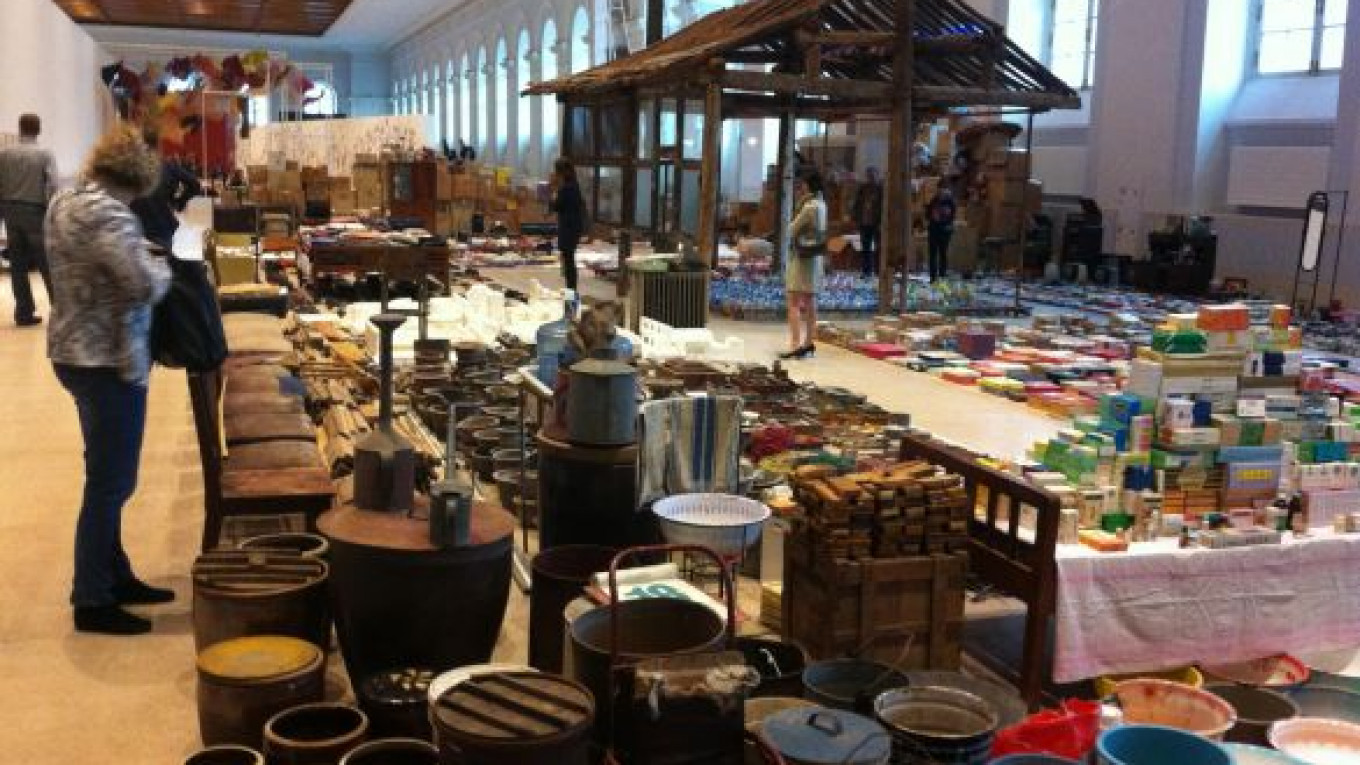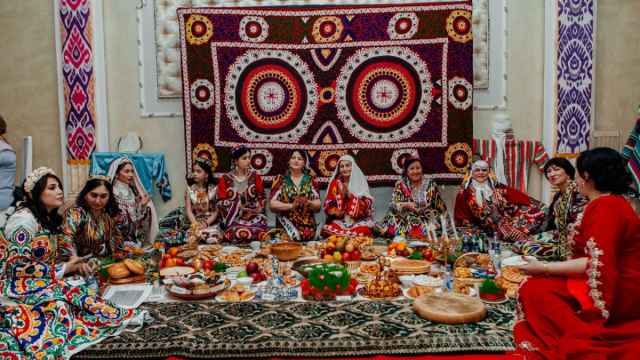The Fifth Moscow Biennale will open its long-awaited main exhibit, "More Light," in Moscow's Manezh on Friday. With works from nearly 100 artists from six continents, the exhibit fills the immense space of Manezh with a wealth of art, much of it large installations, built around the theme of "More Light."
"I wanted an open-ended title, a title that will let all of you have your own interpretation," said curator Catherine de Zegher about the name "More Light," explaining that she "left it up to the audience" to decide what that phrase meant and that she had great faith in the abilities of the viewers to interpret the art.
The exhibit is clearly divided into two sections on separate floors of Manezh. The lower, "dark" level is dominated by video projections, as well as some large hanging installations that stand in pools of warm light, starkly contrasting with their murky surroundings in Manezh's basement.
The video projections were mostly unlabeled at the press viewing, though hopefully this will be rectified by the official public opening of the exhibit so people can know who the artists are. One installation that was labeled was Alan Michelson's "RoundDance," a circle of video screens arranged so that a person standing in the center of the ring could look out and see projections of people dancing around the circle. Michelson, who was present at the opening, said the concept was based in traditional Native American dances.
De Zegher characterized the art of the lower floor as being "slow work," adding that "we need slow attention to be able to relate to each other, the work." The works of the upper floor, though not notably "faster," did certainly seem larger: Many of them were truly immense installations, and the few smaller works, like Simryn Gill's series, "On the Beach," seemed dwarfed both by the other works and by the great airy space of Manezh itself.
De Zegher characterized Manezh as "a building that dwarfs you, that makes you and the works small," saying that it was "a challenging space for an exhibition." Apart from the size of the installations, another surprising feature was the prevalence of Asian artists: While Europeans have long been present in Moscow galleries, it is rare to see contemporary Asian artists exhibited here.
The installation "Waste Not" by Chinese artist Song Dong seemed to be an early crowd favorite. In this work, Dong laid out all of the objects found in his late mother's house, simultaneously creating a memorial to the woman and a chronicle of her daily life in this sprawling expanse of household items.
Dong was joined by his countryman Yang Yongliang, whose work "Infinite Landscape" presents a modern interpretation of traditional Chinese landscape paintings by portraying an endless cityscape of concrete towers. While perhaps not as imposing as Dong's work, Yongliang's image is quite nuanced, though sadly overpowered by the exhibition space.
Apart from China, the subcontinent is represented by N. S. Harsha's work "Punarapi Jananam, Punarapi Maranam", "Again Birth, Again Death", a large painting of a dark, Ouroboros-esque form against a starkly white canvas that seems to be more explicitly associated with the "More Light" theme than many of the other works.
Other notable installations are the full-size blimp made by Belgian artist Panamarenko and the wall of protest slogans created by Tom Molloy.
Apart from the famous foreigners, Russian artists also have impressive works at the show. Pyotr Bely's work, "Source," comments on society's waste by creating a torrent of cement flowing senselessly down a staircase. Alexander Brodsky's memorable "Untitled" depicts a wooden Metro entrance in a field of tinfoil balls.
The whole exhibit was made possible by generous contributions from a number of sponsors. "The Culture Ministry is the main financial backer [of the Biennale]. This is both an honor and a burden," Deputy Culture Minister Ivan Demidov said. Iosif Bakshtein, Commissioner and Art Director of the Biennale, estimated that the Culture Ministry had given about 50 million rubles to the Biennale, about half of the exposition's 100 million ruble budget, the remainder of which was made up by private sponsors like Hyundai, Alfa Bank, Beeline and VimpelCom, as well as the city of Moscow.
"This project could never have happened without the city of Moscow, which has supported us from the beginning," Bakstein said. He added that the Biennale had expanded beyond Moscow this year with exhibits in Murmansk, Yekaterinburg and Nizhny Novgorod, saying "we can say that all of the Russian Federation is participating in the Biennale."
Bakshtein went on to note the numerous special and parallel exhibits of this year's Biennale, specifically recognizing the exhibits by Erwin Wurm, Vadim Zakharov and Andrei Roiter, all of which have already opened. De Zegher likewise emphasized the portions of the Biennale that were not part of the main exhibition, particularly speaking of the tribute to the Russian Avant-Garde that she has helped to organize.
"More Light," the main exhibit of the Moscow Biennale, will be open from Sept. 20 to Oct. 20. For more information and a complete listing of other Biennale events, check the Biennale website at 5th.moscowbiennale.ru.
Contact the author at g.golubock@imedia.ru
A Message from The Moscow Times:
Dear readers,
We are facing unprecedented challenges. Russia's Prosecutor General's Office has designated The Moscow Times as an "undesirable" organization, criminalizing our work and putting our staff at risk of prosecution. This follows our earlier unjust labeling as a "foreign agent."
These actions are direct attempts to silence independent journalism in Russia. The authorities claim our work "discredits the decisions of the Russian leadership." We see things differently: we strive to provide accurate, unbiased reporting on Russia.
We, the journalists of The Moscow Times, refuse to be silenced. But to continue our work, we need your help.
Your support, no matter how small, makes a world of difference. If you can, please support us monthly starting from just $2. It's quick to set up, and every contribution makes a significant impact.
By supporting The Moscow Times, you're defending open, independent journalism in the face of repression. Thank you for standing with us.
Remind me later.






